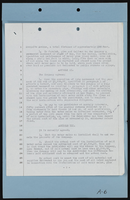Search the Special Collections and Archives Portal
Search Results
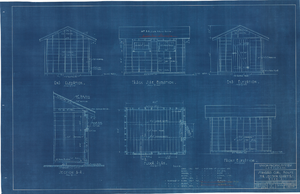
Los Angeles & Salt Lake Railroad Company standard coal house for section quarters: architectural drawing
Date
Archival Collection
Description
From Union Pacific Railroad Collection (MS-00397). The scales are noted in the drawing. The bottom corner of the drawing states, "Union Pacific System L.A. & S.L.R.R. Co. Standard Coal House For Section Quarters. Type-A. Ass't Chief Engineer's Office, Los Angeles, Calif. Drawn By W.V.L-B. Traced By W.B.L-B. Checked By F.W.G. Date Nov 8, 1923. Scales As Noted. Revised Nov. 19, 1926. Drawing No. 15119".
Also written on the drawing: "Built at: Cima, Cal. 1925, Brant ' ', Hayden ' ', Moore ' ', Jean, Nev. '. To be built at Elora, Calif. 1926, Desert ' ', Roach, Nev, '. To be built at Las Vegas, Nev., Dry Lake ', Moapa ', Modena, Utah, Lund ', Milford ', Islen, Nev. 1928 [crossed out, Wann ' [crossed out]."
Image
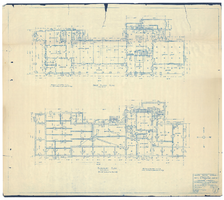
First floor and basement plans for Los Angeles & Salt Lake Railroad hotel and passenger station in Caliente, Nevada: architectural drawing
Date
Archival Collection
Description
From Union Pacific Railroad Collection (MS-00397). The scales are noted in the drawing. The drawing shows the First Floor and Basement Plans. The bottom corner says "Union Pacific System. L.A. & S.L.R.R. Hotel & Passenger Station At Caliente, Nevada. John Parkinson & Donald B. Parkinson Architects. 420 Title Insurance BLDG., Los Angeles. Cal. Drawn L.W.F. Checked. Traced L.W.F. Date 2-25-22. Scale 1/8" = 1'0". Job 162. Sheet 1. Revised 2-28-22. 5-4-22."
Image
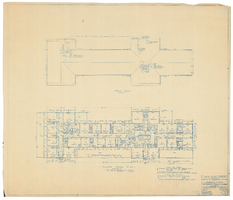
Roof and second floor plans for Los Angeles & Salt Lake Railroad hotel and passenger station in Caliente, Nevada: architectural drawing
Date
Archival Collection
Description
From Union Pacific Railroad Collection (MS-00397). The drawing shows the roof and second floor plans. Scales are noted on drawing. The bottom corner says "Union Pacific System. L.A. & S.L.R.R. Hotel & Passenger Station At Caliente, Nevada. John Parkinson & Donald B. Parkinson Architects. 420 Title Insurance Bldg., Los Angeles. Cal. Drawn R.D.M. Checked S.S.S. Traced R.D.M. Date 2-25-22. Scale 1/8" = 1'0". Job 162. Sheet 2. Revised 3-31-22. 4-25-22. 5-4-22."
Image
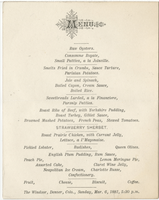
Windsor, menu, Sunday March 6, 1881
Date
Archival Collection
Description
Text
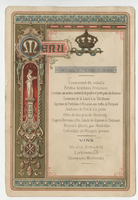
House of Savoy Royal Family residence, menu, February 25, 1884
Date
Archival Collection
Description
Text
Mavis Eggle "Books as They Were Bought" Collection
Identifier
Abstract
The Mavis Eggle "Books as They Were Bought" collection provides a broad overview of printed material from the 1780s through 1949. Gathered by book collector Mavis Eggle, the collection serves as a social history of books, newspapers, and ephemera. Physical characteristics of the books include a variety of printer's marks, publishers' bindings, bookplates, and early subscription libraries. The collection's titles are a diverse and creative gathering of poetry, children' literature, religious texts, broadsides, newspapers, and popular fiction. Together, the items in the Mavis Eggle "Books as They Were Bought" collection illustrate changes in literature, printing and publishing, advertising, and book history over a time period of more than 170 years.
Archival Collection
Alan Byron Olson Photographs
Identifier
Abstract
The Alan Byron Olson Photographs (approximately 1933) consist of one negative album containing 100 photographic negatives taken by Alan Byron Olson around 1933 that depict the Hoover Dam (then known as Boulder Dam) and the Boulder City Hospital. Olson was a medic for the Boulder City Hospital and the images also depict various hospital staff and other locations related to Hoover Dam. The collection also includes digital copies of the negatives.
Archival Collection
Tami Belt oral history interview
Identifier
Abstract
Oral history interview with Tami Belt conducted by Claytee D. White on July 26, 2017 for the Boyer Early Las Vegas Oral History Project.
Tami Belt talks about learning to play golf on the Municipal Golf course where her father worked as a PGA teaching professional. She discusses life in Las Vegas, her family's professions in the city, and shops on Fremont Street like Ronzone's Department Store. Tami shares her career working in public relations and the work she has done with non-profit organizations to combat childhood cancer and homelessness.
Subjects discussed include: Nick Pahor; Emil Pahor; Cancer Camp for Kids
Archival Collection
Joyce Bush oral history interview
Identifier
Abstract
Oral history interview with Joyce Bush conducted by Claytee D. White on September 20, 1995 for the UNLV University Libraries Oral History Collection. In this interview, Bush discusses the formation of her non-profit organization, International Youth for Christ Choir. She explains that she developed the idea in 1994, based on the "True Love Waits" abstinence program of the Baptist Church. She explains how the organization was formed, the process of building a board of directors, ideas about fundraising, publicity, and soliciting donations, attracting youth to the organization, her hopes for the future of the organization, and the reasons corporate sponsorship was unlikely because they tend not to support religious groups.
Archival Collection

